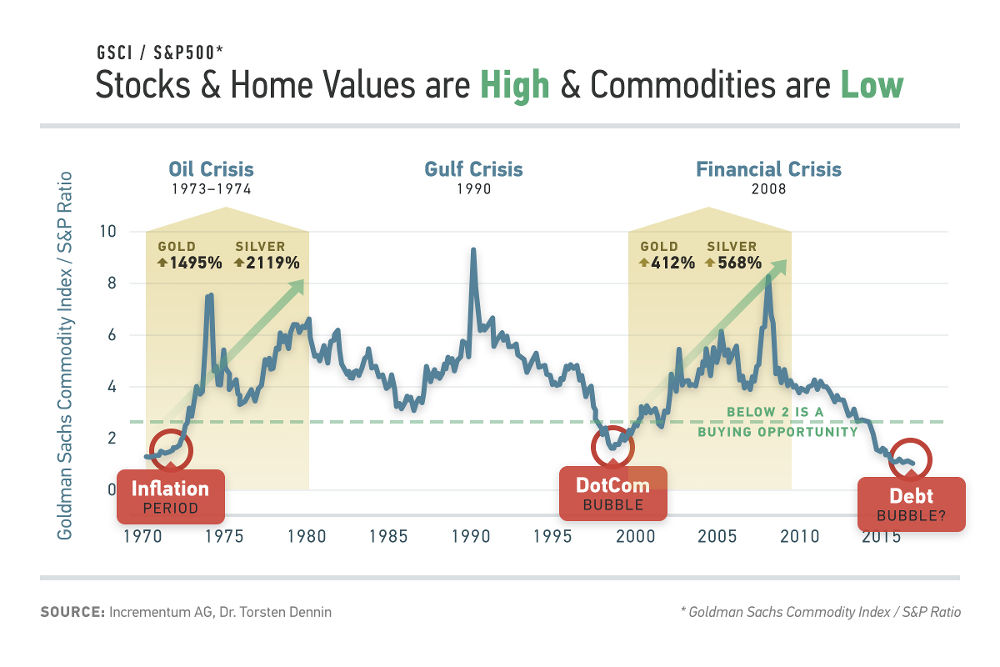The Turning Point for an Unsustainable Economy is Here!

We’ve all known for awhile that the current course of the economy is headed in a direction that is unsustainable. The only question is when does the tide turn?
Chris Martenson and our friends at Peak Prosperity produced a report recently that detailed, not just the stock market trend, but other trends that contribute to the unsustainability of life as we know it.
One example: The Business Cycle of Credit Expansion & Contraction
“The business cycle is a basic structure of any economy based on credit and flows of capital seeking the highest available returns at the lowest available risk. In the expansion stage, households and enterprises borrow more money to boost production and satisfy unmet demand.
In the contraction phase, all the inevitable excesses of freely available credit come home to roost. Marginal investments in new production fail to become profitable and go bust. Marginal household borrowers default, and speculators who bet the farm on momentum plays watch their capital evaporate like mist in Death Valley.
This cycle is an essential dynamic of capitalism, but central banks have attempted to eliminate the contraction phase that acts as the immune system, washing out bad debt and marginal borrowers. This has left the economy saddled with “zombie” corporations and debtors that would be liquidated if monetary policies weren’t enabling their feeble survival.
Keeping zombie banks, corporations and households on life support weakens the financial system by piling up the equivalent of dead wood in the forest. When the inevitable conflagration of bad debt catches fire, many of the healthy trees will also be consumed in the flames.”
Read the condensed article:
The Driving Trends of the Past Decade are now Reversing
by Charles Hugh Smith
Systemic trends and cycles are often causally connected and tend to reinforce each other. This is how a stable, wealthy and resilient society gets hollowed out: trends end and cycles reverse, and forces that added stability, capital and resilience when they were working together are slowly replaced by forces that erode the foundations of wealth and stability. In the current era, five interconnected trends/cycles are either reaching the end of their run or reversing:
1. Central bank distortion/manipulation of markets
2. The yield/interest rate cycle
3. The commodity cycle
4. The stock market cycle
5. Demographics
1. Central Bank Distortion/Manipulation of Markets
Minus the $21 trillion in central bank asset purchases and trillions more in liquidity/credit programs, would the global economy be growing and global markets be at nosebleed heights? We all know the answer is "no."
The returns on this coordinated distortion are diminishing. The “buzz” from the initial injections has faded, and now that the monetary authorities are trying to wean the markets off of their drug, the markets have lost the ability to discover the price of assets, risk and capital on their own.
The benefits of the central bank punch bowl—near-zero interest rates, leverage and access to unlimited credit--are reserved for those few at the top of the wealth-power pyramid; very little of the stupendous wealth created out of thin air has trickled down to the bottom 95%.
The relentless rise in asset valuations has pushed homes out of reach of those living in desirable urban/suburban markets.
2. The Yield/Interest Rate Cycle
Many observers are confident interest rates cannot rise due to the deflationary forces in play. Indeed, they predict a future decline in rates back to zero. Perhaps, but history suggests interest rates typically move in long cycles of roughly two or three decades. The current downtrend in rates dates back to 1981, which means the current trend is pushing 40 years. That’s stretching the historical boundaries.
3. The Commodity Cycle
Compared to the stock market (the S&P 500), commodities are at their cyclical lows. As to what happens next, we need only look at a single chart, courtesy of Incrementum AG:
4. The Stock Market Cycle
We’re implicitly being told that stock markets can loft higher forever, as long as central banks are pumping out the financial stimulus. But nothing goes up forever; valuations get stretched, marginal buyers disappear and doubts about the continuing efficacy of central bank distortions creep in.
Valuations and profits are at the top of their respective cycles, the leaders are faltering, victims of their own dominance, and central banks are feeling pressured to reduce the punch bowl of free money for financiers.
5. Demographics
The world’s working age populace is perched on the precipice of decline while the populace of retirees is exploding, not just in the developed world but in the developing world.
Although many put their hopes on robots generating unlimited wealth that will support the elderly and free the working age populace from labor, the more likely prospect is an economy that cannot fulfill the promises made to retirees back when the worker-retiree ratio was 10-to-1 and not the present-day 2-to-1.
To read part 2 of this Peak Prosperity full report – “Time to Take Action” which lists essential strategies to take in defense of these market and political forces, click here